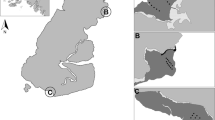Abstract
The ecology of a large sandy beach at Calangute, Goa, Central West India over a 22-month period is described from the point of view of changes in the distribution and abundance of the macrofauna, and of the physical environment of the beach; the dominant effect of the annual monsoon is clearly shown. The results from Calangute are compared with a nearby beach (Colva) and from earlier studies in Southern India. The biology of the dominant wedge-clam Donax incarnatus Gmelin is described, in particular its more rapid breeding-cycle and smaller size at Calangute, compared with other populations studied. The annual production of D. incarnatus has been calculated as 14.7 kcal/m2/year, and has been shown to be relatively low in comparison with other bivalve populations, due to high mortality and the extensive environmental disruption caused by the annual monsoon. It is suggested that the conditions at Calangute are most suitable for settlement, and that the small size of D. incarnatus here is related to the short life span of 6 to 7 months of all individuals.
Similar content being viewed by others
Literature Cited
Ansell, A.D., D.S. McLusky, A. Stirling and A. Trevallion: Comparative studies of beaches. II. Production and energy flow in the macrobenthos. Proc. R. Soc. (1975). (In preparation)
—, P. Sivadas, B. Narayanan, V.N. Sankaranarayanan and A. Trevallion: The ecology of two sandy beaches in South West India. I. Seasonal changes in physical and chemical factors, and in the macrofauna. Mar. Biol. 17, 38–62 (1972a)
—————: The ecology of two sandy beaches in South West India. II. Notes on Emerita holthuisi. Mar. Biol. 17, 311–317 (1972b)
—————: The ecology of two sandy beaches in South West India. III. Observations on the population of Donax incarnatus and D. spiculum. Mar. Biol. 17, 318–332 (1972c)
El Wakell, S.K. and J.P. Riley: Determination of organic carbon in marine muds. J. Cons. perm. int. Explor. Mer 22, 180–183 (1957)
McLusky, D.S. and A. Stirling: The oxygen consumption and feeding of Donax incarnatus and Donax spiculum from tropical beaches. Comp. Biochem. Physiol. (1975). (In press)
Millar, R.J., K.H. Mann and A.J. Scarrett: Production potential of seaweed-lobster community in Eastern Canada. J. Fish. Res. Bd Can. 28, 1733–1738 (1971)
Wade, B.A.: Notes on the ecology of Donax denticulatus (Linne) Proc. Gulf Caribb. Fish Inst. (17th Ann. Sess.) 36–41 (1964)
Author information
Authors and Affiliations
Additional information
Communicated by J.H.S. Blaxter, Oban
Rights and permissions
About this article
Cite this article
McLusky, D.S., Nair, S.A., Stirling, A. et al. The ecology of a Central West Indian beach, with particular reference to Donax incarnatus . Marine Biology 30, 267–276 (1975). https://doi.org/10.1007/BF00390749
Accepted:
Issue Date:
DOI: https://doi.org/10.1007/BF00390749




